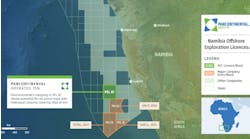Grzegorz Zajfert, MEWO S.A.
Polish consortium MEWO S.A. and Pro Geofizyka Kraków has completed the first 3D ocean bottom node (OBN) seismic survey in the Polish Economic Zone of the Baltic Sea.
The Wolin 3D seismic project is a first stage of prospecting in the offshore concession acquired by Central European Petroleum in 2017. The concession is in the southwestern part of the Pomeranian Bay in the Baltic Sea. Carried out from May to June 2019, the project consisted of 48,500 source positions over 125 sq km (48 sq mi) in water depths of 2-15 m (7-49 ft), with some 22,800 man-hours recorded on site. Because of port traffic, shallow water, yachting and fishing activity 785 OBNs were deployed as receivers.
Six vessels dedicated to specific tasks such as deployment, source, equipment recovery, guard and multi-task were based in the port of S´winoujs´cie.
The first stage of the campaign included pre survey performed by a Reson SeaBat 7125 multi beam echo sounder. This allowed accurate bathymetry and seabed quality of the area to be determined.
The next stage was to prepare the 785 OBN receivers (OBX 750E from Geospace Technologies) with appropriate gain settings determined during a test on site. Then the OBNs were deployed on the seabed in a regular 400-m x 400-m (1,312-ft x 1,312-ft) grid. Then the seismic source line acquisition was carried out over predetermined lines.
This acquisition phase, despite marine traffic, fishing, pleasure yachting, marine mammals and weather, had to be completed within 60 days due to the battery life in the OBN receivers. To avoid exceeding the OBN battery time it was necessary to maintain a sufficiently high shot repetition rate (2,800 shots per day) on the Sercel GI gun seismic source which was fired every 50 m (164 ft).
After the source acquisition, a Seaeye Falcon ROV was used for OBN recovery.
Due to the ultra-shallow water, vessel choice was critical. The vessel had to have shallow draft but large enough deck space and payload capacity to install the compressed air supply for the air gun source. It also had to have accommodation for 20 people, data acquisition rooms, workshop and technical facilities as well as supplies. Being able to manage this all on a single vessel platform saved cost and time.
During the survey work, high standards were maintained to protect the natural environment and minimize any impact on it. A passive acoustic monitoring system for detecting and identifying potential marine mammal presence, source soft start procedure, and an acoustic deterrent device were all employed to ensure the disturbance of marine life was minimized. During the main seismic acquisition, the onboard marine mammal observers did not detect any marine mammals in the vicinity of the operation.
While the final processing of the seismic data is yet to be completed the acquisition and initial results point to a highly successful survey outcome for Poland’s first ever offshore 3D OBN seismic survey. •




